Carole Wilson Lewis
written by Dianne Carofino
Carole Wilson Lewis is one of many Guatemalan food lovers who enjoyed traditional Guatemalan meals as they were growing up but today do not know how to prepare it themselves. Therein lies the problem: how to learn to prepare traditional Guatemalan food in today’s decidedly untraditional world.Carole recounts that, as a child, she loved to spend time in her grandmother’s kitchen. During that time, she says, the family cook held a respected and full-time position, not only in her grandmother’s home, but in many Guatemalan homes. The cook’s position needed to be full time, because food preparation was so time consuming. Carole remembers that when she was very young, the cook still went to the Guatemala City mercado by horse and carriage. Then, when the food arrived home, it took hours of preparation before the wonderful meals flowed out of the kitchen.
Although her grandparents built one of the first modern homes in Guatemala, designed by a protégé of the well-known French architect Le Corbusier, Carole’s grandmother insisted upon building a poyo into her kitchen. There, alongside her modern appliances, the traditional poyo burned coals on its surface. On top of these coals, meat and a variety of vegetable were boiled together, producing the delicious broth of a cocido. A dos fuegos was used to produce a roasted meal. Food would be placed in a pan on top of the coals of the poyo. Another pan, also with coals in it, would be placed on top of the first, providing heat from both top and bottom. Preparation of tortillas would, of course, begin with the grinding stone, or piedra de moler.
In search of the meals of her childhood and youth, Carole has utilized many older cookbooks. In some recipes, she has found that the given amount of ingredients can still be used today. But, with the oven replacing a dos fuegos, for example, it is difficult to accurately judge cooking temperatures and time. In other recipes, the amount of ingredients to use is difficult to determine. The oldest cookbook Carole has utilized, Lybro de Cocyna, which dates from 1844, is an anonymous compilation of recipes published by the University of San Carlos. One of the recipes calls for “one cent’s worth of cinnamon.” What is the equivalent amount of cinnamon for today’s recipe? A teaspoon? A tablespoon? More? Less?
The oldest cookbook Carole has utilized, Lybro de Cocyna, which dates from 1844, is an anonymous compilation of recipes published by the University of San Carlos
Carole’s passionate hobby of the past several years has been to authentically adapt ingredients and cooking methods from traditional recipes to today’s lifestyle. This has involved Carole’s analysis of many versions of a specific recipe, which results in her own compilation, or “consensus” recipe, and then trials of that recipe in Carole’s own kitchen.
Starting with the 1920s cookbook by Doña Crecencia de López, Carole has utilized, among others, the cookbooks of Doña Catalina de Balsells, Doña Aurora Sierra Franco de Álvarez and Doña Julia de Montano. Who knows? There may one day be a cookbook by Doña Carole Wilson Lewis, one that would include an easier version of these recipes for the modern lifestyle.
Carole’s own education in cooking began as a young bride. Her first husband, André Trombetta, was a Frenchman whose mother had learned to cook with the noted French chef, Mme. Bonnamour. Mme. Bonnamour, among her other culinary achievements, supervised the cooking in the boyhood home of Prince Phillip, husband of Queen Elizabeth of England. Carole recounts that her husband “was always talking about how to bone a chicken or how to make puff pastry.”
Her husband’s descriptions further fueled Carole’s own interest in all things related to cooking, and in the early 1980s, she opened Le Marmiton, “The Kitchen Helper,” a cooking store in Zone 9, Guatemala City. The store sold kitchen utensils, and various well-known individuals gave cooking lessons. Copeland Marks, a food historian who wrote for Bon Appétit gave lessons on Southeast Asian cooking. Marks was also the author of False Tongues and Sunday Bread: A Guatemalan and Mayan Cookbook. Jean Francois, now owner and chef of Tartines, taught French cooking at Le Marmiton. With the death of her husband, Carole closed Le Marmiton and eventually moved to La Antigua Guatemala.
Carole shares with us the following traditional recipes, updated for today’s cook and kitchen, but retaining special traditional features, such as the use of the jug with a small mouth, the tinaja. She has also provided the Spanish words for ingredients, for our English speakers who would like to shop in the mercado or smaller tiendas, as well as the prices which she has most recently experienced. The Piloyada Antigüeña is one of the dishes which was prepared using traditional methods from Carole’s childhood, and which we can all enjoy today, with the use of our modern appliances.
Fresco de Súchiles
This is a fermented drink made from fruit, most commonly from pineapple.
In an earthen jug with a small mouth
(a tinaja) place the following:
• Peel of one pineapple (piña)
• 1 cup toasted dried kernels of yellow corn (maiz amarillo)
• ½ brick of panela, diced (panela is a cake of brown sugar)
• 1 inch of fresh ginger, crushed (jengibre)
• ½ cup toasted barley (cebada)
• 4 dried jocotes (jujubes) found at spice stalls in the mercado (optional).
• 10 cups of water
Tie up the following in a piece of cheesecloth and add to the jug.
• 5 toasted allspice seeds (pimienta gorda)
• 1 tsp toasted anise seeds (anís)
Cover the tinaja with cheesecloth and let ferment undisturbed for three days.
Strain and serve cold. Add more water as needed.
Chinchivir
A típico drink of Antigua, is made from a “secret” recipe passed from generation to generation. Very few people have the recipe. Café Ana has it on its menu. You can also buy it at Ferretería Armas on 7a avenida norte (a hardware store where you can also buy cucurucho costumes in all sizes) and at a house next to Colegio La Salle on 4a avenida norte.
If you mix
• ginger beer or
• ginger tea with Fresco de Súchiles, you can come up with your own version of Chinchivir.
Refresco de Chan
This is a refreshing drink made from the seeds called Chan (Hyptis suaveolens), a favorite drink of the peoples of the New World. The conquistadors rejected it because of its association with ¨pagan¨ rituals. It is high in protein, and is taken to avoid constipation. You can find it in the mercado at the spice stalls.
Soak 2 oz. of chan seeds (semillas de chan) in 2 quarts of water until the seeds swell, about one hour.
Add:
• Sugar, or other sweetener, to taste
• 1 cup lime juice
Serve over ice or very cold.
Piloyada Antigüeña
Piloyes are large red beans with white stripes. They can be bought in the market for about Q8 a pound. (Prices depend on season and harvest)
In a large heavy pot, soak overnight in water to cover 1 lb. Piloyes with 1 head of garlic and 1 large onion
The next morning, bring the pot to a boil and add:
• 1 lb pork tenderloin or other pork (pork tenderloin is lomo de cinta and costs approximately Q20 per pound)
Boil gently until both beans and meat are done. The cooking time will be approximately 35-60 minutes, depending on the type of pot you use. Do not overcook the beans. They should remain whole. Take out the meat and drain the beans. While still hot, toss the beans with
• 2 tbsp vinegar
Cut the meat into small cubes, mix with the beans and set aside to cool.
While the meat and beans are cooling, prepare the following:
• Queso duro, to taste, grated (Queso duro is a salty cheese used grated like parmesan)
• ¼ Queso de capas cut in cubes (Queso de capas is a fresh cheese, similar to fresh mozzarella, found in the supermarket
• 1 bell pepper, chopped (Chile pimento Q1.25)
• 12 black or white butifarras (see below) boiled for 20 minutes and then sliced
• 8 ripe tomatoes, chopped (Q3/1b)
• 1 large onion, chopped (Q1.25)
• ¼ cup parsley, chopped (perejil)
Mix the above with beans and meat and season with the following:
• ½ tsp black pepper
• 1 tsp fresh thyme (tomillo) chopped
• 2 bay leaves (laurel)
• Salt, to taste
• Oil, to taste (about 6 tbsps)
• Vinegar, to taste (about 1 tbsp)
Refrigerate.
This recipe will serve 15 as a side dish,
or 6 as a main course.
*Butifarras are sausages, originally from Cataluña, which were brought to the new world during the Colonial era. They are made with ground lean pork, salt, pepper, bacon and spices. White butifarras are made with meat only and black butifarras are made with some pork blood. These can be bought in the small tiendas of Antigua, supermarkets, and the mercado.
Food photos by Rudy A. Girón
- Making Fresh Tortillas by Rudy Giron – AntiguaDailyPhoto.com
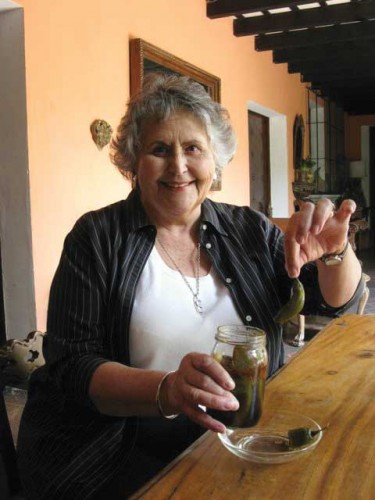
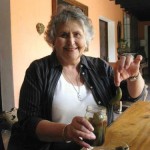
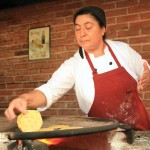
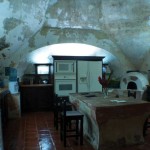
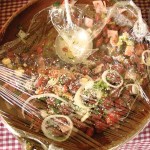
Carol! Q bonito reportaje!!! Un abrazo,
Carole,
I don’t know if you remember me, I am Vivian’s son. She and Vida Chenoweth would like to be in touch with you and have asked me to help them get in touch with you. You can write to Vivian at. vbmorales@me.com and Vida at vida_chenoweth@sil.org.
Thanks,
PEter
Dear Carole!
Do you remember me??
Thank you for so many memories of my stay in Guatemala and particularly of you. You don’t know how many times I have thought of you over the years and wondered how to get in touch with you.
I hope this works and, perhaps, we can communicate.
Jim Udick